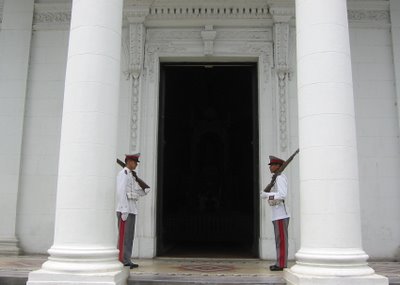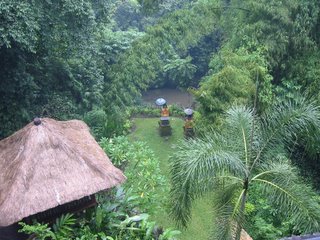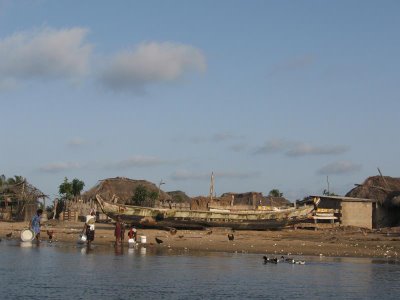
by Michael Snyder
Every year, I head to New Orleans to participate in the pre-Lenten carnival. I’ve done this without fail for two decades-- even in February of 2006, mere months after the natural disaster-- and the less natural Bush-connected aftermath-- that has since come to define the area in many minds.
I choose the early weekend of the twelve-day festival that culminates in Mardi Gras, because it offers plenty of celebration with easier access to amenities, but fewer yahoos over-indulging, acting the fool, and making the rest of us pay for their folly. There is a stretch of Bourbon Street that should be overseen by the NCAA, since many nights, teams of drunken college students appear to be competing in the sport of distance vomiting. That sort of behavior increases during Carnival season, but it’s easy to avoid when you know where it tends to happen.
So I went back to New Orleans yet again. I couldn’t not go. And I was so happy to be there. In its own way, this trip was as lovely as all of my prior visits, despite the knowledge that so much has changed, will never be the same, and needs to be done to insure the town’s future. At least, the entertainment districts were in good shape-- with the exception of a few storefronts that remain shuttered. Music rang out of every corner, whether it was a ragtime band on Royal Street, trumpeter Leroy Jones at Preservation Hall, the old-timey New Orleans Jazz Vipers at the Spotted Cat, or vocalist John Boutte and his ensemble at d.b.a. As usual, there were moments that I’ll absolutely cherish:
Sunday night, I ate dinner at Coop’s-– an informal joint in the French Quarter-- with a buddy from San Francisco and the great singer-songwriter-guitarist Alex Chilton of Box Tops and Big Star fame. I was still recovering from the indulgences of the previous night’s costume party in the two-story warehouse of a renowned local artist. I’d had my fill of the weekend’s street parades with float-riding maskers tossing beads, aluminum doubloons, plastic cups and who-knows-what-else at rambunctious crowds. I’d had the thrill of watching the afternoon’s Krewe of Barkus dog parade as a thousand cleverly-costumed canines dragged their masters through the Quarter to the cheers of appreciative onlookers. (This year’s Barkus theme was “A Streetdog Named Desire.” Loved the dachshund in the torn t-shirt with the name “Stanley Bow-Wow-Ski” scrawled across its back.) I was ready for the joys of good Cajun-style cooking and good company.
Local resident Chilton lives in the Tremé, the primarily African-American neighborhood that spawned jazz giant Louis Armstrong, and he’s been happy there for many years. Yet these are troubling times. Between bites of an oyster po’boy, Chilton expressed his concern over the loss of thousands of hard-working lower-middle-class New Orleanians who were flooded out of their homes by Hurricane Katrina and may never come back. Suddenly, he noticed the sound of R&B queen Aretha Franklin coming over the restaurant’s sound system. She was singing the Burt Bacharach-Hal David classic “I Say a Little Prayer.” Chilton marveled at her stirring gospel inflections that clearly turned the object of the singer’s affection from a boyfriend or new-found lover to a certain Lord and Savior. “Not what Burt and Hal intended,” Chilton said with a grin, before devouring the rest of his po’ boy.
On Monday afternoon, the day after the Grammys, I was walking down Frenchmen Street in the Faubourg Marigny district next to the Quarter. I’d just been hanging out with fervent NoLa musician Kenny Claiborne, the guitar-slinging soul rebel who defied civic, state and national troops in the wake of Katrina; stayed in his home after the citywide evacuation; and, with the aid of a gas-powered generator, his home studio and a couple of speakers on his balcony, played DJ eight hours a day for his few remaining neighbors, the police, soldiers, and relief workers. With a microphone in hand, he asked passersby for requests, spun his favorites, and called it Radio Marigny. He’s a remarkable guy.
Anyway, I was heading back to Decatur Street to quaff a pint of Crescent City Brewhouse’s Carnival Bock, and suddenly, there was legendary producer-composer-keyboardist-singer Allen Toussaint driving his shiny convertible, top down, a female companion by his side. They slowly tooled past the strip of hotspots on Frenchmen: Ray's Boom Boom Room, Café Brazil, d.b.a., the Spotted Cat, and the venerable Snug Harbor where pianist Ellis Marsalis-– father of jazz masters Wynton, Branford, Delfeayo, and Jason-- is in residence with his trio every Friday night. The previous evening, Toussaint was in Los Angeles to attend the Grammy ceremony. “The River in Reverse,” his 2006 collaboration with Elvis Costello, had been nominated in the category of "best pop vocal album,” but John Mayer won the award.
Hours later, Toussaint was back home to New Orleans, and cruising along in elegant fashion. People on the sidewalk greeted him with words of respect and encouragement. All on Frenchmen who saw him knew him and gave him his props. Toussaint-- local royalty-- acknowledged each of them with a gracious nod, and motored on.
Despite the banners and posters trumpeting “Rebuild, Restore, Renew” or similar positive sentiments, a number of T-shirts for sale at various souvenir shops in the Quarter tell a different story. Of course, there are the usual vulgar inscriptions such as the popular “I Got Bourbon-Faced on Shit Street.” Then, there are shirts of a different stripe, reading “Make Levees, Not War”; “FEMA: The New Four-Letter Word,” “F.E.M.A.: Fix Everything My Ass”; and, both lurid and pointed, “Katrina Gave Me a Blow-Job I’ll Never Forget.” All of it is justified. It’s been way over a year since the flood. The fix-up has been slow and, in some sectors, non-existent.
After what Katrina did, did the weather deities think that a tornado or two could faze the Crescent City? Lightning flashed, wind howled, rain came down, and at least one tornado ripped through and ripped up the streets on the night before I left town, by then, completely spent from my long weekend of food, drink, music, dance, and camaraderie. A number of buildings were leveled, some people were injured, and an elderly woman died. More tragedy for a locale that has far exceeded its recommended dose. Yet…
The next day dawned sunny and warm. Around noon in Armstrong Park’s Congo Square, the current model of Paul Kantner’s Jefferson Starship played a free concert sponsored by Microsoft. A polyglot crowd whooped it up to a lively Starship career retrospective, preceded by a few songs from a reconstituted Quicksilver Messenger Service.
Yep. The party resumed, and will continue into next week. It'll only stop when Fat Tuesday turns to Ash Wednesday, and Lent begins. Caught in the vortex of Carnival, people will willingly succumb to pleasure and (thanks to spicy food and excessive drink) pain until the madness ends. Then, it’ll happen again next year.
You can’t stop Mardi Gras.







































